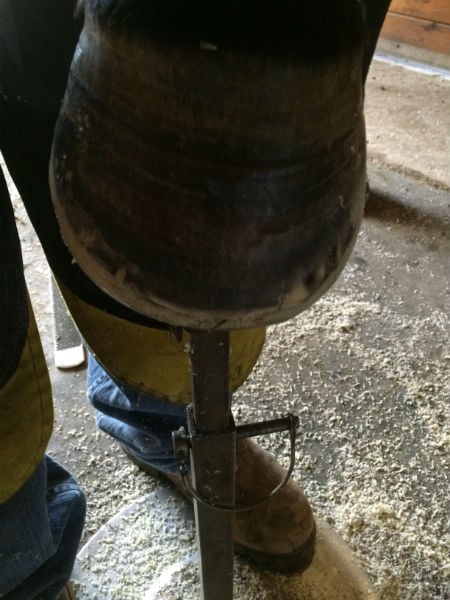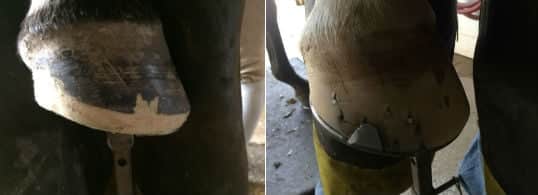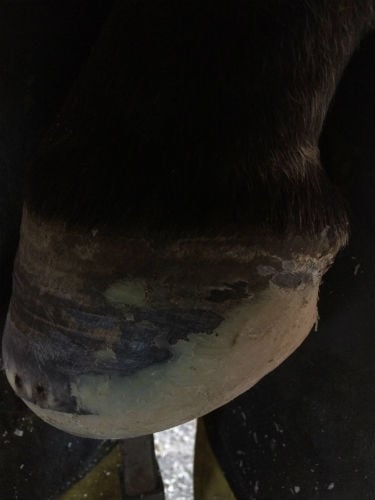Glue-On Horse Shoes: An Alternative for Horses With Damaged Hooves
If you keep you eye on the news you may have seen an article out of the UK advertising “Crocs for horses!” These glue-on shoes feature a plastic coated shoe that wraps around the hoof wall. While this style of shoe hasn’t become popular in the US, several farriers we spoke with do agree that glue-on shoes can be a valuable tool to help deal with horses who have thin or damaged hoof walls where nails simply cannot be used. We spoke with two East Coast farriers to get their thoughts on glue on shoes.
What Are Glue On Horseshoes?
Josh Eggink is a farrier out of Frederick, MD who has been working with glue on shoes for the past ten years. He explained that there are many types of situations where you might consider glue on shoes for a horse. Horses with poor quality hoof walls, flat feed, or low heels can all benefit from glue on shoes over the conventional nailed on shoe. He also mentioned horses suffering from laminitis. “Due to the inflammation, sometimes laminitic horses will be in too much pain to nail shoes on. The nails can make them more sore. Glue-on shoes are a good way to get around that.”
These images show two of Eggink’s shoeing jobs using glue (left) and traditional nails (right.)
There are several styles of glue-on shoes, but the two most common are the “cuff and tab” style or the direct bond glue-on. “The cuff style can be a quick or easier way attaching to the outside of the hoof wall,” Eggink explained. “Some styles of these have a built in rim pad or plastic padding that can help horses going through laminitis or those who issues with sole pressure and need to be raised from ground.”
The direct bond involves gluing an aluminum or plastic shoe to the hoof using glue mixed with shredded fiberglass composite cloth. If there are chunks missing out of the hoof or heel, this method allows the farrier to fill in these voids. “The direct bonds I believe tend to be a bit healthier for hoof and don't do damage to hoof when removed. The direct bonds also don't cover as much of outside wall allowing it to breath and the hoof wall to stay healthier in my experience.”
The GluShu “Crocs for horses” advertised in the UK involve a metal shoe coated with plastic that wraps around the hoof wall. These brightly colored shoes are advertised as an effective shoeing technique as well as a way to make a fashion statement with your horse’s feet. Designer John Wright explained, “'It's a brilliant alternative for horses in the UK, and we have spoken to lots of vets who agree its a marked improvement for horse’s feet.” The designers boast of the quick application time and better design than the American method of gluing on shoes.
Still, it is obvious that the U.S. farriers we spoke with aren’t fully convinced. Eliot Pargament, a farrier in Northern Virginia, explained, “Everyone just shakes their head. It’s not a popular product for the working horse.” Both Pargament and Eggink agree that glue-on shoes are best used as a temporary measure when your horse’s hoof is compromised.
Advantages and Disadvantages of Glue-On Horseshoes
As expected, there are some advantages and some disadvantages to using glue-on shoes. The main advantage is that they can be great for horses who do not have a strong healthy hoof wall to nail into. Eggink explained, “Glue-on shoes also can "raise " a hoof further from ground or allow you to build up heels on a horse with low or compromised heels.”
The main disadvantage is cost. Glue on applications are more expensive since they often require aluminum shoes. Steel shoes cost around $5-8 for a pair, while aluminum costs $10-15 per pair. Eggink said, “Steel shoes will rust and break the bond of glue and shoe.” He continued, “Glue on shoes regardless of cuff style or direct bond are much more expensive than nail on shoes. Cuff style tends to be slightly more of a cost than the direct glues. The cuff styles cost more for the shoes but typically you use less glue.” Overall, a typical farrier will charge anywhere from $125-200 more a pair for glue on shoes over regular shoes. Finally, the glue can sometimes limit the hoof capsule’s ability to expand.
In Pargament’s opinion, “You can get stuck in a loop with glue. When you pull it off, it can pull off new hoof growth.” That is why it is extremely important that you choose a farrier that knows how to use glue correctly so as to not damage the hoofs when removing shoes.
Application Challenges: It’s All in the Bond
When a farrier is applying glue on shoes, it is vitally important that they secure a strong bond so that the shoes are secure on the hoof. Eggink explained that the two most important variables are the environment and the horse’s cooperation. “To ensure a good bond you need a clean dry environment. The hoof needs to be clean and dry as possible as does the shoe for the glue to bond well.” After cleaning and trimming the hoof, some farriers will place the horse’s foot in a fabric booty while preparing the shoe, so that the foot stays dry and clean.
After the glue has been applied it will need a few minutes to cure or set. “This is why the horses cooperation is so important!” He added that regardless of shoe type, the application is key. The shoe needs to be properly fitted to a well-trimmed and flat foot. If properly applied, your horse shouldn’t have any trouble adjusting to glue-on horseshoes.

After the glue has been applied, it will take several minutes for the glue to set. This is why the horse's cooperation is key.
Eggink has worked a great deal with glue-on shoe application. He explained, “Glue-on shoes are a great aid when I encounter horses with damaged or weak hooves. They've also helped me with some laminitis cases. In my practice, gluing is a temporary fix, or sometimes like hitting the "reset" button on damaged or poor quality hooves.” He is based out of Frederick, Maryland and has ten years of experience. He is a Certified Journeyman Farrier with the American Farrier’s Association and even competes in their national horseshoeing competition and the World Champion Blacksmiths event.
If your horse is having trouble with nailed on shoes, you might consider glue on shoes as an alternative. Do your research and ask your own farrier to see if this is a good option for your horse. Who knows, you might be glue on shoes the next time the farrier comes around!
To contact Joshua Eggink for farrier services around Frederick, MD, email him at EgginkHorseshoeing@gmail.com. To contact Eliot Pargament for farrier services in Northern Virginia near the DC metro area, email him at metrofarrier@gmail.com or call 703-887-5232.



